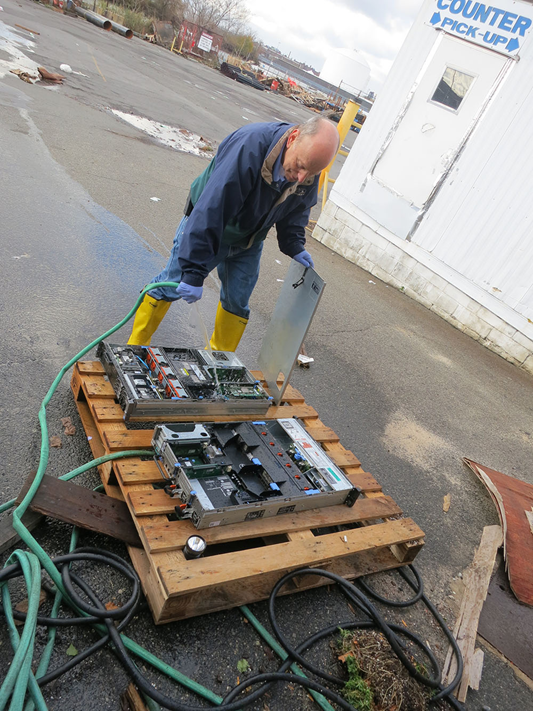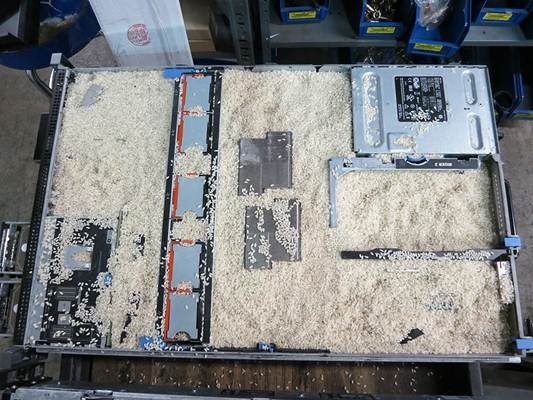A tale of how the Dell PowerEdge server Hurricane Sandy survived
Last year, America was not too lucky - in late October, she was hit by a tropical hurricane Sandy , the eighteenth Atlantic cyclone with a female name and a non-female character. We will not lie if we say that it was remembered to the inhabitants of the entire planet, although it was not the most powerful in the history of mankind - that was the fault of the 2012 disaster film on the big screens, in which the predictions of the Mayan Indians about the end of the world It was in 2012 that they were interpreted very clearly: the world would die from the strongest earthquakes and tsunamis. And so, the events of the film began to unfold in real time, and it was even scary to watch it on TV - what to say about the victims and witnesses of the raging elements.
The extent of the destruction caused by Sandy was enormous. Killed 185 people, another 22 are considered missing, and the total damage caused to the United States, Canada and the countries of the Atlantic Ocean, is estimated at 146.5 billion dollars. It’s hard to imagine how many houses and offices were destroyed, how many businesses suffered from the destruction and breakdown of computer equipment, but we know for sure that at least one server survived Hurricane Sandy with almost no consequences.
A week before the killer cyclone originated in the waters of the Atlantic, system administrator Wayne Miller purchased a 12-generation Dell PowerEdge R720 generation server for Davis & Warshow, powered by the latest Intel Xeon E5 processors. He planned to transfer data from the server of the previous generation R710, and use the old machine as a backup storage. It was a thoughtful step, as the business of Davis & Warshow, a New York-based supplier of kitchen and bathroom products, was growing rapidly - the company already had 10 stores in Manhattan, Long Island and Brooklyn, and there were plans to open a few more.
')
Further events are not difficult to predict. The Davis & Warshow headquarters in Queens was completely flooded, and the new Dell PowerEdge R720 server swam for several days in a hearty cocktail of salty ocean water and liquid leaked from UPS batteries located in the same server room (shaking up, but not mixing - obviously not about this case).

The red line is the water level.
Of course, Miller had no hope that the server could be reanimated, but, nevertheless, he decided to make at least an attempt - the most important data were stored on the server, and the attempt was not torture.
Knowing that the warranty on the “wetted” device is no longer valid, Miller rinsed the server with fresh water from a watering hose, dried it thoroughly and covered it with dry rice, which was supposed to absorb the maximum amount of moisture.


A week later, when the elements stopped raging, and the power supply resumed, Miller removed the remnants of rice and turned on the server out of curiosity. Surprisingly, the Dell logo appeared on the screen, the fans whirled, spitting out the last rice grains. Ultimately, Miller managed to save all four virtual servers and transfer data, despite the fact that the operating conditions of the R720 were clearly violated.
We do not want to seem prejudiced, but it is unlikely that what happened is considered an accident. Still, the device survived not short-term contact with water - it literally floated in it for several days, and the water was not fresh, but salty. In short, the strength of Dell PowerEdge servers is tested in extreme conditions, and we have no reason to doubt their durability and reliability. But we recommend to keep on hand a couple of bags of rice. So, just in case.
PS
By the way, this “familiarity” of Dell and Sandy is not over. Dell created the Red Cross Digital Operations Center (DigiDOC) for the American Red Cross (American Red Cross), the world's first command social media center to provide humanitarian aid. Digidoc was successfully deployed during Hurricane Sandy, Hurricane Isaac and several other natural disasters in 2012.
But we will tell about it next time!
The extent of the destruction caused by Sandy was enormous. Killed 185 people, another 22 are considered missing, and the total damage caused to the United States, Canada and the countries of the Atlantic Ocean, is estimated at 146.5 billion dollars. It’s hard to imagine how many houses and offices were destroyed, how many businesses suffered from the destruction and breakdown of computer equipment, but we know for sure that at least one server survived Hurricane Sandy with almost no consequences.
A week before the killer cyclone originated in the waters of the Atlantic, system administrator Wayne Miller purchased a 12-generation Dell PowerEdge R720 generation server for Davis & Warshow, powered by the latest Intel Xeon E5 processors. He planned to transfer data from the server of the previous generation R710, and use the old machine as a backup storage. It was a thoughtful step, as the business of Davis & Warshow, a New York-based supplier of kitchen and bathroom products, was growing rapidly - the company already had 10 stores in Manhattan, Long Island and Brooklyn, and there were plans to open a few more.
')
Further events are not difficult to predict. The Davis & Warshow headquarters in Queens was completely flooded, and the new Dell PowerEdge R720 server swam for several days in a hearty cocktail of salty ocean water and liquid leaked from UPS batteries located in the same server room (shaking up, but not mixing - obviously not about this case).

The red line is the water level.
Of course, Miller had no hope that the server could be reanimated, but, nevertheless, he decided to make at least an attempt - the most important data were stored on the server, and the attempt was not torture.
Knowing that the warranty on the “wetted” device is no longer valid, Miller rinsed the server with fresh water from a watering hose, dried it thoroughly and covered it with dry rice, which was supposed to absorb the maximum amount of moisture.


A week later, when the elements stopped raging, and the power supply resumed, Miller removed the remnants of rice and turned on the server out of curiosity. Surprisingly, the Dell logo appeared on the screen, the fans whirled, spitting out the last rice grains. Ultimately, Miller managed to save all four virtual servers and transfer data, despite the fact that the operating conditions of the R720 were clearly violated.
We do not want to seem prejudiced, but it is unlikely that what happened is considered an accident. Still, the device survived not short-term contact with water - it literally floated in it for several days, and the water was not fresh, but salty. In short, the strength of Dell PowerEdge servers is tested in extreme conditions, and we have no reason to doubt their durability and reliability. But we recommend to keep on hand a couple of bags of rice. So, just in case.
PS
By the way, this “familiarity” of Dell and Sandy is not over. Dell created the Red Cross Digital Operations Center (DigiDOC) for the American Red Cross (American Red Cross), the world's first command social media center to provide humanitarian aid. Digidoc was successfully deployed during Hurricane Sandy, Hurricane Isaac and several other natural disasters in 2012.
But we will tell about it next time!
Source: https://habr.com/ru/post/195876/
All Articles